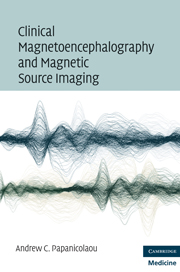Book contents
- Frontmatter
- Contents
- Contributors
- Preface
- Section 1 The method
- Section 2 Spontaneous brain activity
- 11 MEG recordings of spontaneous brain activity – general considerations
- 12 Normal spontaneous MEG – frequently encountered artifacts
- 13 Spontaneous MEG morphology
- 14 Abnormal spontaneous MEG
- 15 Contributions of MEG to the surgical management of epilepsy – general considerations
- 16 MEG investigations in lesional epilepsies
- 17 MEG investigations in nonlesional epilepsies
- 18 Pediatric nonlesional epilepsy surgery
- Section 3 Evoked magnetic fields
- Postscript: Future applications of clinical MEG
- References
- Index
15 - Contributions of MEG to the surgical management of epilepsy – general considerations
from Section 2 - Spontaneous brain activity
Published online by Cambridge University Press: 01 March 2010
- Frontmatter
- Contents
- Contributors
- Preface
- Section 1 The method
- Section 2 Spontaneous brain activity
- 11 MEG recordings of spontaneous brain activity – general considerations
- 12 Normal spontaneous MEG – frequently encountered artifacts
- 13 Spontaneous MEG morphology
- 14 Abnormal spontaneous MEG
- 15 Contributions of MEG to the surgical management of epilepsy – general considerations
- 16 MEG investigations in lesional epilepsies
- 17 MEG investigations in nonlesional epilepsies
- 18 Pediatric nonlesional epilepsy surgery
- Section 3 Evoked magnetic fields
- Postscript: Future applications of clinical MEG
- References
- Index
Summary
Definitions
From a prospective study in newly diagnosed epilepsy cases, we find that 60% of patients become seizure-free on their first (47%) or second (13%) antiepileptic drug (AED). However, even when pharmacological treatment is effective, side effects and complications can severely limit success and general viability of the drug schedule. The 30% to 40% of patients who either do not respond to AED or suffer from side effects have only a small chance for subsequent remission with a second or third type of drug therapy. For many of these patients, epilepsy surgery is a viable therapy option. Optimal planning for such surgical procedures requires exact and reliable localization of the epileptogenic zone and determination of its spatial relationship to eloquent cortex. This zone is part of a broader network of abnormal activity. Within this network, different zones that have different functional significance for interictal and ictal epileptic activity can be distinguished.
A basic description of the epileptogenic zone was formulated by Penfield and Jasper in 1954. They defined the epileptogenic zone as the zone of actual seizure onset that had to be removed to achieve seizure freedom. The concept of Talairach and Bancaud extended this definition to include the early seizure-spread zone also. A third view stated the large network hypothesis where all parts of the neuronal network are equally important and seizure freedom can be achieved by interruption of the network at any level. Chauvel and coworkers integrated the irritative and epileptogenic zone in a model focusing on the dynamic features of interictal activity and the identification of pacemakers.
- Type
- Chapter
- Information
- Publisher: Cambridge University PressPrint publication year: 2009



